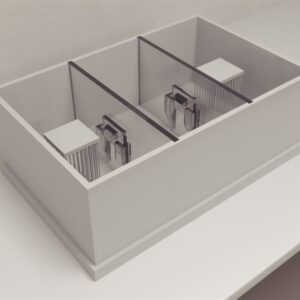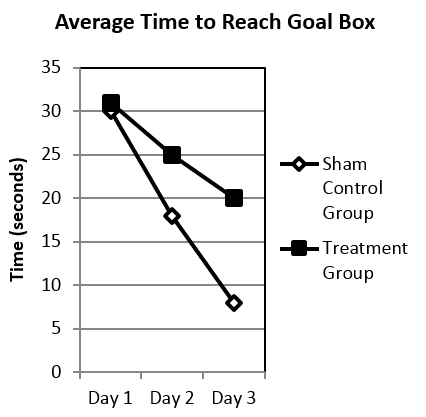$2,490.00 – $2,890.00Price range: $2,490.00 through $2,890.00
The Hebb-Williams Maze (HWM) is a behavioral testing tool designed to evaluate spatial learning and memory in small animals, particularly rats and mice. This maze features a central platform with multiple arms extending outward. Typically constructed from acrylic, the arms of the maze can be baited with food or other incentives.
In a typical test, the animal is placed on the central platform and allowed to navigate the maze. Researchers track the animal’s movements and analyze various metrics, such as the number of arm entries, the duration spent in each arm, and the number of errors made, to assess its spatial learning and memory capabilities.
The Hebb-Williams Maze is a widely recognized and reliable method for evaluating cognitive function in rodents. It has been extensively used in neuroscience research to study areas like aging, brain injury, and neurological disorders. The maze is named after Donald Hebb and Richard Williams, who developed it in the 1940s.
MazeEngineers provides the Hebb-Williams Maze test as part of their product offerings.

MazeEngineers empowers preclinical neuroscience research with meticulously designed, customizable behavioral apparatuses. From manual classic mazes to fully automated smart systems, we provide the tools scientists need to capture high-quality, reproducible data for studies on learning, memory, anxiety, and depression.

bool(false)


Mouse Features | |
+$100 with Doors | |
Acrylic | |
No Odor | |
Matte finish for non reflective surfaces | |
Easy clean with 70% Ethanol | |
Base separates from walls | |
Includes inserts for all 12 Hebb Williams Combinations |
Rat Features | |
+$100 with Doors | |
Acrylic | |
No Odor | |
Matte finish for non reflective surfaces | |
Easy clean with 70% Ethanol | |
Base separates from walls | |
Includes inserts for all 12 Hebb Williams Combinations |

The Hebb-Williams Maze is a widely used behavioral task designed to study spatial working memory in animals (Pritchett & Mulder, 2004; Raut et al., 2014). Researchers have found that rodents exhibit an impressive ability to learn and recall spatial locations, especially when motivated by food rewards. This observation has been harnessed into a behavioral task involving a maze with a square layout and adjustable internal walls, which can be reconfigured for each trial. The Hebb-Williams Maze battery includes six acquisition layouts and twelve testing layouts, all requiring the use of spatial working memory. This task is sensitive to various factors, including the effects of drug administration and disease models, which can influence an animal’s ability to navigate the maze.
Developed in the 1940s by Hebb and Williams as a method to measure “animal intelligence” (Hebb & Williams, 1946), the maze has since evolved. Rabinovich and Rosvold expanded on the original design by creating a series of maze configurations, which remain the standard today (Rabinovich & Rosvold, 1951). Initially designed for use with rats, the maze has been adapted for mice in more recent studies. Over the years, the task has been employed in various research contexts, such as assessing memory and learning in animals exposed to prenatal alcohol, in models of ADHD, and in studies involving drugs that affect dopamine levels (Bond & DiGiusto, 1978; Kamimura et al., 2001; Raut et al., 2014).
The Hebb-Williams Maze apparatus is composed of a square area, typically measuring 60×60 cm with 10 cm high walls for mice, and 75×75 cm with 25 cm high walls for rats. One corner of the maze is designated as the starting point, while the opposite corner features a goal box equipped with a well for holding a food reward. The internal walls of the maze are adjustable, allowing different paths to be created for each trial. These walls are usually made of opaque black or white material and are available in a matte finish to minimize reflections. The maze is often placed on a table and does not require a dedicated stand.
The maze trial involves two phases: acquisition (A) and testing (B), each with its own set of maze configurations.
The testing environment should be dimly lit to enable the animals to see and explore without being stressed by bright lights.
A video camera mounted above the maze is used to record the experiments, and tracking software can be employed to monitor the animals’ movements within the maze. Alternatively, live scoring can also be conducted.
The Hebb-Williams Maze is designed to assess spatial working memory in animals. This test allows researchers to compare the learning and memory capabilities of animals in a control group against those in a treatment or disease model group by observing how efficiently they navigate the maze and reach the goal boxes. The maze battery comprises twelve different layouts, which the animals must learn over several days during the acquisition and testing phases. Typically, control animals quickly learn the maze layouts, whereas animals with impaired learning or memory might make more errors or struggle to reach the goal box.
Evaluating Spatial Working Memory with the Hebb-Williams Maze
To properly conduct the Hebb-Williams Maze test, animals must undergo habituation, followed by acquisition and testing phases. Before starting these phases, the animals are food restricted to ensure they are motivated to seek the food reward in the maze, with their body weight maintained at 80-90% of their original weight during testing.
During the habituation phase, animals are gradually introduced to the maze apparatus for set periods. At this stage, the internal walls of the maze are removed to prevent the animals from learning the maze layout before the acquisition phase. After several habituation sessions, a food reward is placed in the goal box to familiarize the animals with the reward system. If an animal fails to locate the food reward, it is guided to the goal box and shown the food.
In the acquisition phase, the animals are introduced to the maze with its internal walls in place, using the first six layouts depicted above (A). A specific acquisition criterion is established, such as completing all six mazes within a predetermined time. Once this criterion is met, the animal can progress to the testing phase.
During the testing phase, the animals are evaluated based on the time it takes them to reach the goal box. There are twelve different maze layouts (shown in figure B), each with only one correct path to the goal box. An error is recorded if the animal enters a section of the maze that does not lead to the goal box. A successful trial is when the animal quickly reaches the goal box without exploring incorrect paths. If the animal fails to reach the goal box within five minutes, it is guided to the goal box and then removed from the maze. Each animal undergoes several trials over three consecutive days.
Typically, animals are not provided with visual cues to aid in learning the correct path through the maze, though some versions of the test incorporate such cues.
To minimize stress, modifications can be made to the habituation phase of the protocol. Additionally, researchers can tailor the number and duration of acquisition and testing trials to better suit their animals and specific experimental objectives.
The data obtained from the Hebb-Williams Maze generally consists of the times it takes the animal to reach the goal box, and the number of errors the animal made on its way there. These measures can be graphed directly to compare the differences in learning between a sham


Using graphs like these to compare the time taken to complete the maze and the number of errors made provides a clear visual representation of spatial working memory and learning in animals. Control animals are expected to demonstrate quick learning, completing the maze faster with each successive testing day. In contrast, animals treated with drugs that impair cognitive function may exhibit slower learning, with longer completion times and an increased number of errors. These measurements can also provide insights into the animals’ ability to encode and retrieve spatial information (Raut et al., 2014). Typically, a cohort of 15-20 animals is sufficient to achieve statistically significant results (p-values < 0.05) using ANOVA and Tukey’s test (Raut et al., 2014; Bond & DiGiusto, 1978).
One of the key advantages of the Hebb-Williams Maze is that it imposes minimal stress on the animals. Unlike the water version, where animals must swim to find an escape platform—resulting in higher stress levels—the original maze design is much gentler. The low-stress environment allows for more accurate observations of the animals’ working memory as they navigate the maze. However, it is worth noting that the required food restriction prior to testing can introduce some stress.
The protocol for the Hebb-Williams Maze often involves several days of habituation, acquisition, and testing, depending on the specific modifications made. This can extend the time needed to gather data.
As with any task designed to measure learning and memory, it is important to recognize that multiple factors influence the animals’ behavior in the maze. Variables such as anxiety and exploratory tendencies should be taken into account when interpreting the results of spatial memory assessments.
| Species | Mouse, Rat |
|---|
There are no questions yet. Be the first to ask a question about this product.